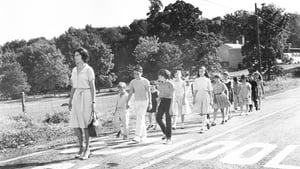Video Sources 0 Views

Download Ladybug Ladybug (1963) Colorized HD | Kathryn Hays | Cold War Psychological Drama | Frank Perry
Synopsis
A Haunting Journey Into Fear: Ladybug Ladybug (1963) in Colorized HD

Step into the tense, uncertain world of Ladybug Ladybug (1963), now brilliantly colorized for a new generation. Directed by Frank Perry and written by Eleanor Perry, this psychological drama explores the raw anxiety of the Cold War era through the eyes of children and teachers at a rural elementary school. Inspired by a real incident during the 1962 Cuban Missile Crisis, the film’s docudrama style and ensemble cast deliver an unforgettable meditation on innocence, dread, and the shadow of nuclear war.
Ladybug Ladybug Plot Summary: A Day That Changes Everything
On a seemingly ordinary morning, the tranquility of a countryside school is shattered when an air raid siren blares, signaling a possible nuclear attack. Unaware that the alarm is a false one, the staff and students are thrust into a state of panic. The principal, John Calkins (William Daniels), and the pregnant secretary, Mrs. Forbes (Kathryn Hays), must make impossible decisions as they organize the evacuation of the children.
Teachers lead groups of students across the rural landscape, each child confronting the crisis in their own way. Some children reach home only to find their parents dismissive or absent, deepening their sense of isolation. One girl, clutching her pet goldfish, hides under her bed, convinced the end is near. Another boy, caring for his grandmother with dementia, turns the evacuation into a game to coax her into the basement. Meanwhile, a group of children find shelter in a bomb shelter, only to refuse entry to a desperate classmate, Sarah, who is left to fend for herself in the growing chaos.
The film’s tension builds as Sarah, rejected by her peers, crawls into an abandoned refrigerator to hide—a chilling metaphor for the era’s existential fears. Her fate remains unresolved, underscoring the uncertainty and helplessness that permeate the story. The film’s final moments, as a boy runs through the countryside to find Sarah while the ominous sound of planes fills the sky, leave viewers with a haunting sense of ambiguity and dread.
Cast and Characters
-
Kathryn Hays as Mrs. Forbes, the vulnerable yet resolute school secretary
-
William Daniels as Principal John Calkins, struggling to maintain order
-
Jane Connell as Mrs. Maxton, the dinner lady
-
Nancy Marchand as Mrs. Andrews, a teacher leading children home
-
Alice Playten as Harriet, the bossy girl in the bomb shelter
-
Marilyn Rogers as Sarah, the isolated and desperate student
-
Christopher Howard as Steve, Sarah’s sensitive friend
-
Miles Chapin as Joel, the misunderstood boy
-
Estelle Parsons and other notable debuts
Genre and Cinematic Style
Ladybug Ladybug is a Cold War psychological drama, blending elements of docudrama, suspense, and coming-of-age storytelling. The film’s slow pacing, naturalistic performances, and stark cinematography create a creeping sense of doom, immersing viewers in the emotional landscape of its young characters. The colorized HD restoration enhances the film’s visual impact, highlighting the rural setting and period details.
Historical Context and Inspiration
Released in 1963, Ladybug Ladybug was inspired by a true story published in McCall’s magazine, based on an incident at a California school during the Cuban Missile Crisis. The film captures the pervasive anxiety of the era, when the threat of nuclear war was a daily reality for American families. Its title, borrowed from the classic nursery rhyme, serves as a bitterly ironic counterpoint to the story’s dark themes.
Colorization and Restoration
This colorized edition of Ladybug Ladybug utilizes advanced digital technology to bring new depth and vibrancy to Frank Perry’s original black-and-white vision. The restoration process involved meticulous frame-by-frame color mapping, enhancing the emotional resonance of each scene while preserving the film’s stark, documentary-like atmosphere. The result is a hauntingly beautiful visual experience that draws contemporary audiences into the heart of Cold War America.
Technical Details
-
Director: Frank Perry
-
Screenplay: Eleanor Perry
-
Based on: “They Thought the War Was On!” by Lois Dickert
-
Cinematography: Leonard Hirschfield
-
Edited by: Armond Lebowitz
-
Music: Bob Cobert
-
Production Company: Francis Productions Inc.
-
Distributed by: United Artists
-
Runtime: 82 minutes
-
Download Format: MP4
-
Resolution: HD (1080p)
-
Compatibility: All major devices (smartphones, tablets, computers, smart TVs)
Critical Reception and Legacy
Ladybug Ladybug is widely regarded as a powerful and unsettling exploration of Cold War trauma, praised for its flawless ensemble performances and chilling atmosphere. The film’s unique focus on children’s psychological responses to existential threat sets it apart from other nuclear-era dramas. Critics have compared its haunting imagery to Ingmar Bergman’s The Seventh Seal, particularly in scenes where children march across the hills, singing as they face the unknown.
The film marked the debut of several actors, including William Daniels and Estelle Parsons, and is often cited as one of Frank Perry’s most accomplished works. Its influence can be seen in later films that explore childhood anxiety and social panic.
FAQs
-
Q: Is Ladybug Ladybug based on a true story?
-
A: Yes, it was inspired by a real incident during the Cuban Missile Crisis, as recounted in a McCall’s magazine story.
-
-
Q: What makes the colorized version special?
-
A: The colorization enhances the film’s emotional impact and period authenticity, making it more accessible to modern audiences.
-
-
Q: Who are the leading actors?
-
A: Kathryn Hays and William Daniels deliver standout performances as the school’s secretary and principal.
-
-
Q: What genre is Ladybug Ladybug?
-
A: It’s a Cold War psychological drama with elements of docudrama and suspense.
-
-
Q: What are some alternate titles or references?
-
A: The film is sometimes referred to as a Cold War docudrama or anti-nuke drama.
-
Download Now in HD!
Rediscover a forgotten classic—download Ladybug Ladybug (1963) in stunning colorized HD today!











